Until a few years ago it seemed liked nobody in the western world even knew that Turkey had hookahs and now they are the standard by which many others are judged. Trends come and go but the truly traditional pipes always seem to persevere with a loyal following.
What Makes Turkish Hookahs Special?
Let’s start off by saying there are exceptions to every rule in the hookah world because every style of hookah is just a variation on the earliest designs that were moved along trade routes and adapted to local tastes, materials and fashion. The same holds true today and what one person defines as a Turkish hookah may not include every hookah made in Turkey. This article refers to what is commonly known as a Turkish style hookah.
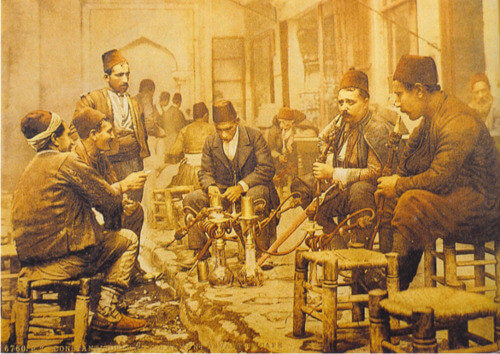
Hookah reached Turkey in the 17th century and was seen as a status symbol. This meant that the pipes were often ornate and beautiful pieces of art made from expensive materials and designed to show the affluence of the owner. While there existed cheaper hookahs for the general population, the pipes that left the most lasting impression on artists and the word of hookah were those owned by royalty and the rich. This meant pipes made with gold and silver inlay, amazingly fine engraving and even precious gems set into the various pieces of the pipe. The following pipe was made by a French jeweler in the 17th century after visiting Safavid-era Persia. The entire pipe is covered in turquoise and rubies while the design is similar to the coconut pipes that were the origin of the hookah we all know today.
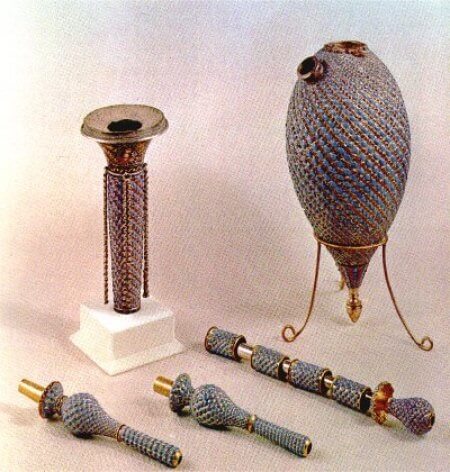
While many forms of hookah were popular the design that became the most dominant and pervasive was one with a glass, brass or ceramic vase that could stand on its own flat bottom and sported a flexible hose that made smoking easier. This can be seen in the picture at the top of this article and in the following paintings by Jean-Leon Gerome
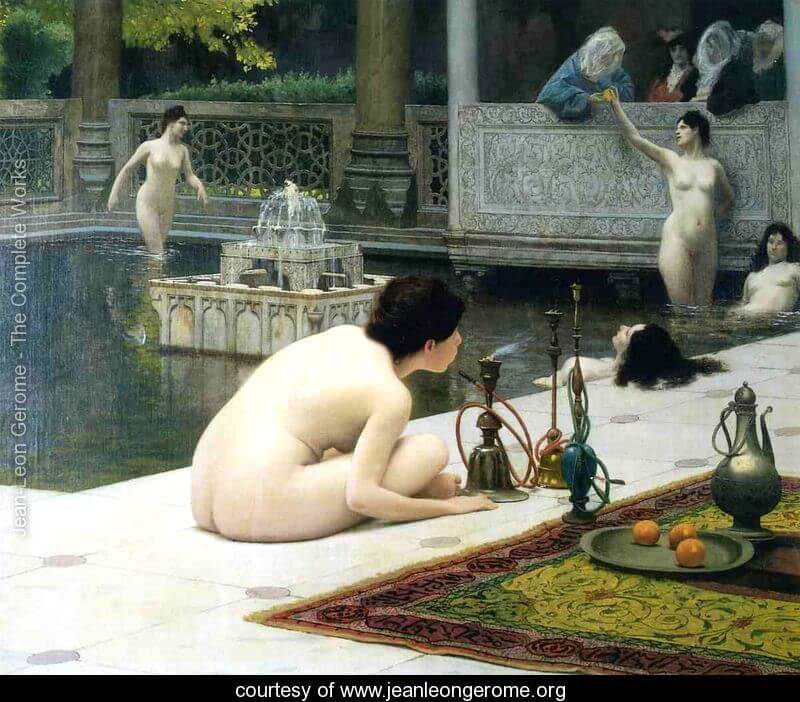
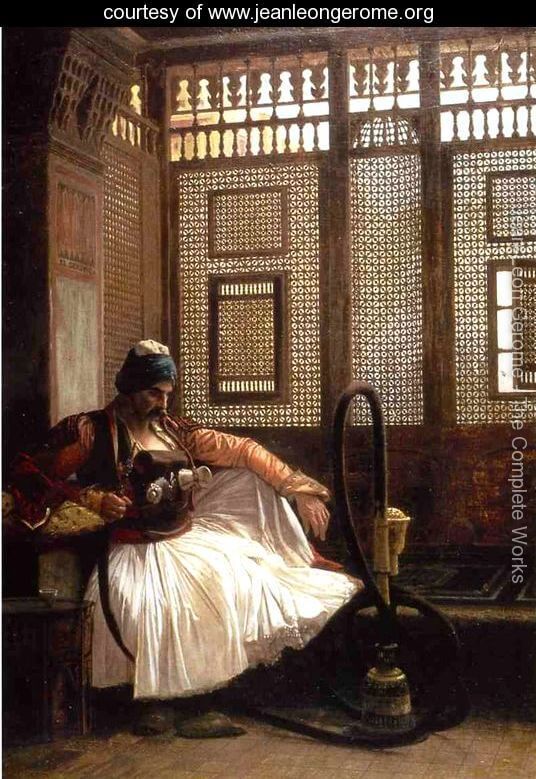
Modern Turkish hookahs still pay homage to the past though they’ve become a bit standardized in their designs. As demand for hookahs that doubled as fine work of art deflated the market was filled with solid brass stems that sport elaborate designs cast into the metal rather than engraved and the extra flourish of gems and precious metal work was forgotten. Many companies and craftsman abandoned hookah as a product for items more profitable and only a few companies were left making a limited number of designs in a fairly similar style.
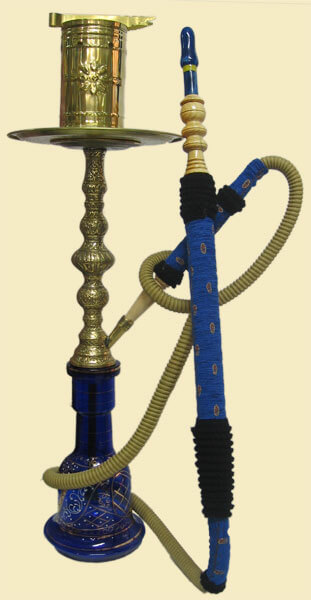
Pictured above is an Elmas nargile. Elmas means diamond and it is one of the most popular brands currently producing modern Turkish hookahs. This is a good example of what can be expected from a true Turkish hookah. The stem is made from cast brass covered in small details and perched upon a Turkish glass vase. The hose is almost always camel leather and ends with an astoundingly long handle that’s tipped with an ornate and beautiful mouthpiece. In the following image you can see that the bowl port is female style as was the popular style in Turkish hookahs through most of the 20th century and until very recently.
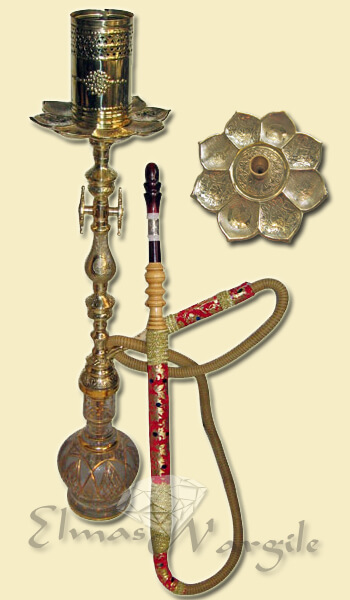
Another notable attribute of Turkish hookahs is the lack of a purge valve. The purge was a feature considered to be both lazy and aesthetically displeasing on a hookah pipe and Turkish artisans almost entirely refused to add them to their pipes. Recently, in response to western tastes and demand, some less traditional companies have been producing Turkish hookahs with both purge valves and male style stems designed to use Egyptian style bowls and some of the more popular designs like the Tangiers Phunnel. Previously Turkish hookah smoker were limited to traditional Turkish bowls or forced to resorting to adapters that would allow them to use female bowls.
Brands of Turkish Hookah
Elmas
At one time Elmas was the only option for buying a Turkish hookah in the west. This is the brand that most others are replicating and adapting to the modern market. Elmas holds true to their roots and only produces a limited number of models all with traditional ports and no purge valves. Very expensive and considered to be quite high quality if overpriced. They are still basically the only game in town when it comes to fully traditional, Turkish hookahs with a notable bran name and you’ll pay a price for that luxury.
Othmani
Imported originally by Medwakh.com and now quite hard to find, this brand is a fusion between traditional Turkish and modern Egyptian. The pipes themselves are fairly traditional with female style stems but with the addition of a modern purge valve, threaded down-stem on some models, and a common chamber heart. A middle ground between traditional and modern. The supply of this brand seems to have dried up.
El Nefes
Brought to the market be Hookah John. A line of hookahs made with Turkish styling but with a purge valve and male stem. Adapted for the western market and utilizing thinner metal in some areas of the stem, which makes them lighter than Elmas but very heavy stems none the less. The cast details on the stems are less complete meaning there will be bare patches on areas such as the bottom of the tray rest. Readily available and sometimes cheaper than truly traditional brands depending on the model.
Brandless
Not everything is branded in Turkey and there are many distributors that deal with hookahs of unknown origins. Some of these are diamonds in the rough while others can be of questionable quality. There are a few different places to get them but more and more have been adopting the male stem and purge valve to adapt to western demand. These are a gamble but sometimes you win big.
That’s it
Turkish hookahs are nothing mystical. They smoke pretty much the same as other hookahs. Some will have great smoking properties while others will be mediocre. Some use extremely high quality materials and craftsmanship while others are lacking. Every style of hookah has stars and duds but you stack the deck in your favor when buying from a well known and respected distributor or company as is the case with all hookahs.
If you have any questions that I haven’t answered here, please ask them. I’ll be going over Turkish hoses, bowls and vases at a later date.
